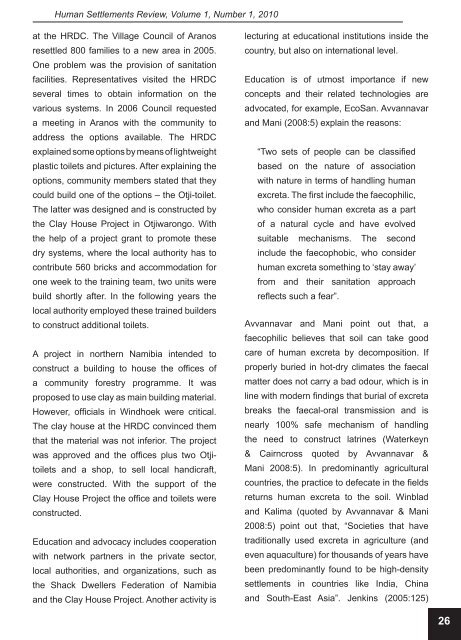Human Settlements Review - Parliamentary Monitoring Group
Human Settlements Review - Parliamentary Monitoring Group
Human Settlements Review - Parliamentary Monitoring Group
Create successful ePaper yourself
Turn your PDF publications into a flip-book with our unique Google optimized e-Paper software.
<strong>Human</strong> <strong>Settlements</strong> <strong>Review</strong>, Volume 1, Number 1, 2010<br />
at the HRDC. The Village Council of Aranos<br />
resettled 800 families to a new area in 2005.<br />
One problem was the provision of sanitation<br />
facilities. Representatives visited the HRDC<br />
several times to obtain information on the<br />
various systems. In 2006 Council requested<br />
a meeting in Aranos with the community to<br />
address the options available. The HRDC<br />
explained some options by means of lightweight<br />
plastic toilets and pictures. After explaining the<br />
options, community members stated that they<br />
could build one of the options – the Otji-toilet.<br />
The latter was designed and is constructed by<br />
the Clay House Project in Otjiwarongo. With<br />
the help of a project grant to promote these<br />
dry systems, where the local authority has to<br />
contribute 560 bricks and accommodation for<br />
one week to the training team, two units were<br />
build shortly after. In the following years the<br />
local authority employed these trained builders<br />
to construct additional toilets.<br />
A project in northern Namibia intended to<br />
construct a building to house the offices of<br />
a community forestry programme. It was<br />
proposed to use clay as main building material.<br />
However, officials in Windhoek were critical.<br />
The clay house at the HRDC convinced them<br />
that the material was not inferior. The project<br />
was approved and the offices plus two Otjitoilets<br />
and a shop, to sell local handicraft,<br />
were constructed. With the support of the<br />
Clay House Project the office and toilets were<br />
constructed.<br />
Education and advocacy includes cooperation<br />
with network partners in the private sector,<br />
local authorities, and organizations, such as<br />
the Shack Dwellers Federation of Namibia<br />
and the Clay House Project. Another activity is<br />
lecturing at educational institutions inside the<br />
country, but also on international level.<br />
Education is of utmost importance if new<br />
concepts and their related technologies are<br />
advocated, for example, EcoSan. Avvannavar<br />
and Mani (2008:5) explain the reasons:<br />
“Two sets of people can be classified<br />
based on the nature of association<br />
with nature in terms of handling human<br />
excreta. The first include the faecophilic,<br />
who consider human excreta as a part<br />
of a natural cycle and have evolved<br />
suitable mechanisms. The second<br />
include the faecophobic, who consider<br />
human excreta something to ‘stay away’<br />
from and their sanitation approach<br />
reflects such a fear”.<br />
Avvannavar and Mani point out that, a<br />
faecophilic believes that soil can take good<br />
care of human excreta by decomposition. If<br />
properly buried in hot-dry climates the faecal<br />
matter does not carry a bad odour, which is in<br />
line with modern findings that burial of excreta<br />
breaks the faecal-oral transmission and is<br />
nearly 100% safe mechanism of handling<br />
the need to construct latrines (Waterkeyn<br />
& Cairncross quoted by Avvannavar &<br />
Mani 2008:5). In predominantly agricultural<br />
countries, the practice to defecate in the fields<br />
returns human excreta to the soil. Winblad<br />
and Kalima (quoted by Avvannavar & Mani<br />
2008:5) point out that, “Societies that have<br />
traditionally used excreta in agriculture (and<br />
even aquaculture) for thousands of years have<br />
been predominantly found to be high-density<br />
settlements in countries like India, China<br />
and South-East Asia”. Jenkins (2005:125)<br />
26









![National Research Foundation Annual Report 2008 / 2009 [Part 2]](https://img.yumpu.com/49774036/1/177x260/national-research-foundation-annual-report-2008-2009-part-2.jpg?quality=85)







